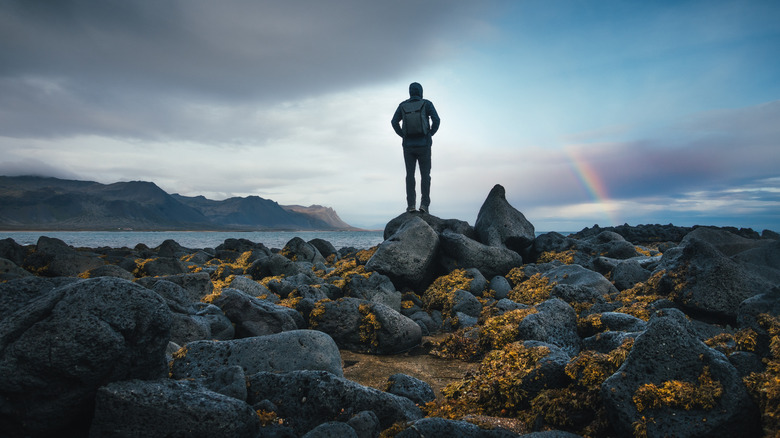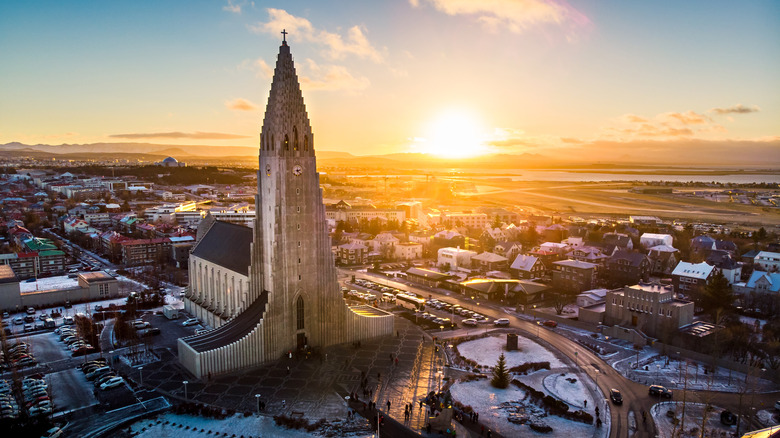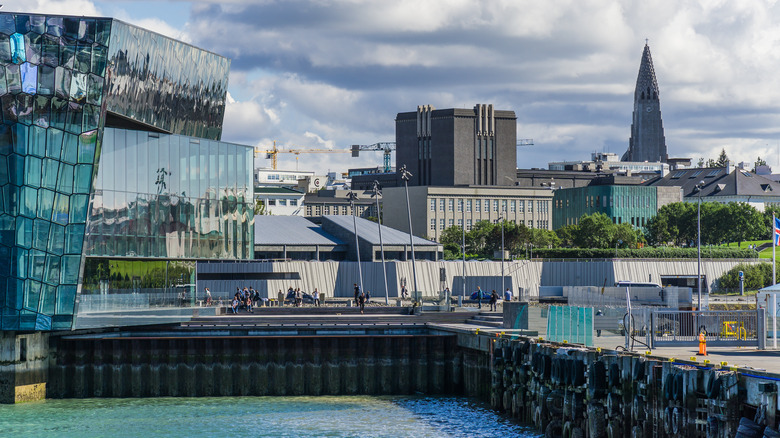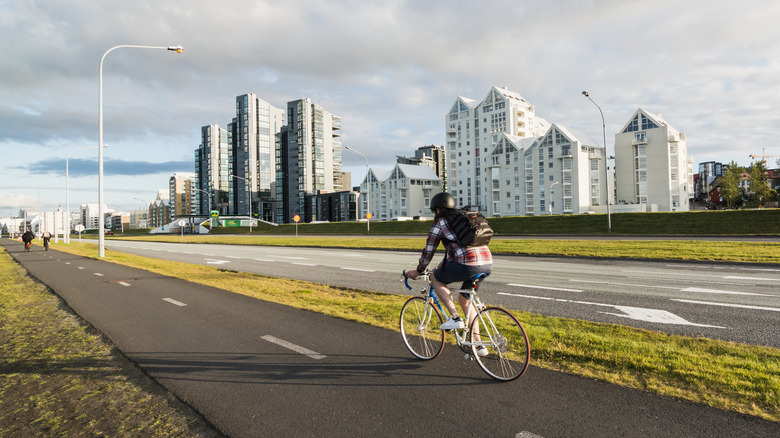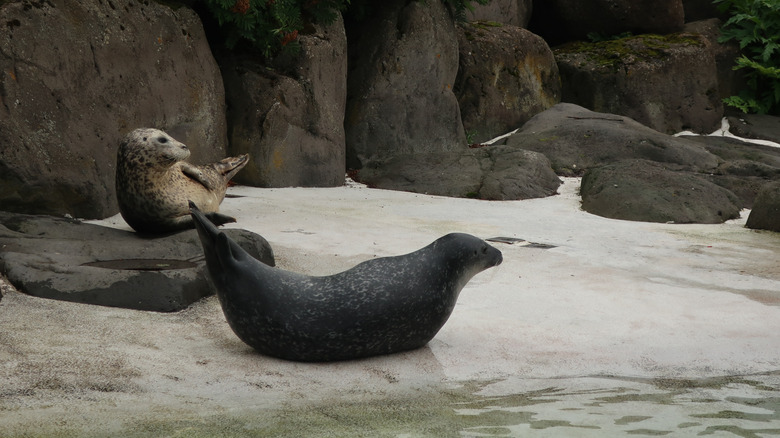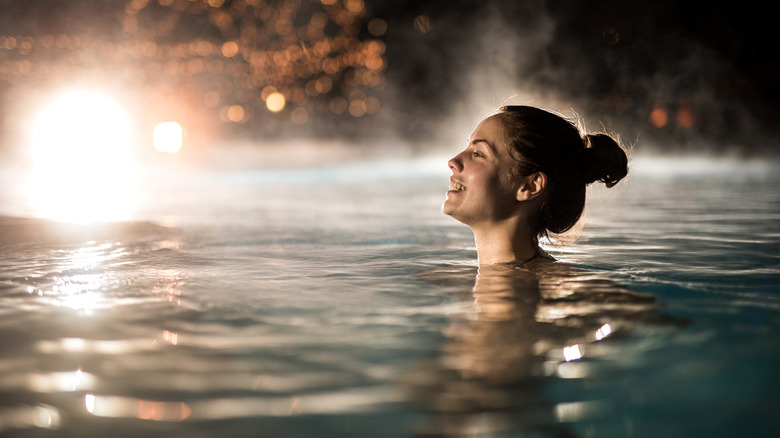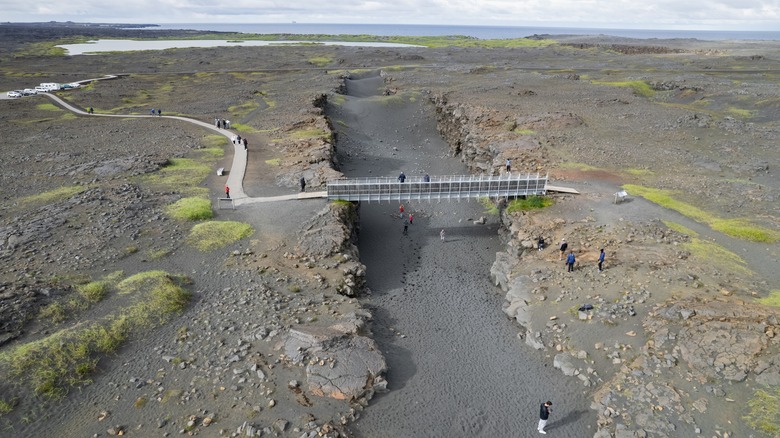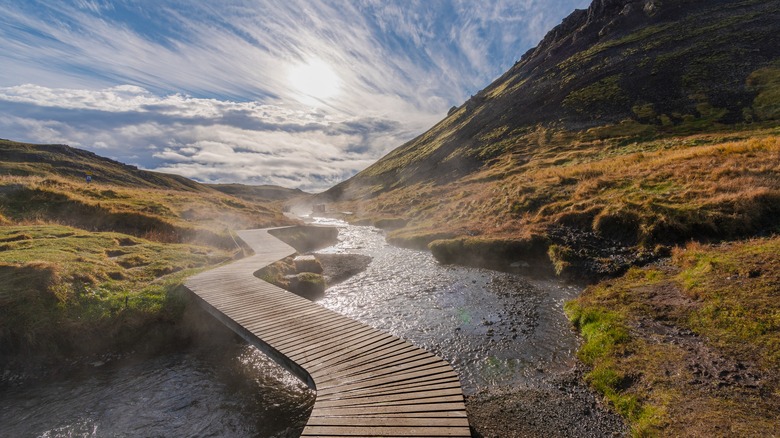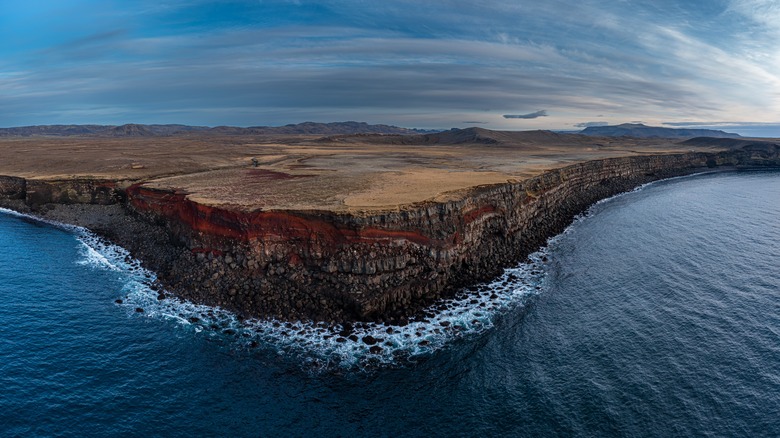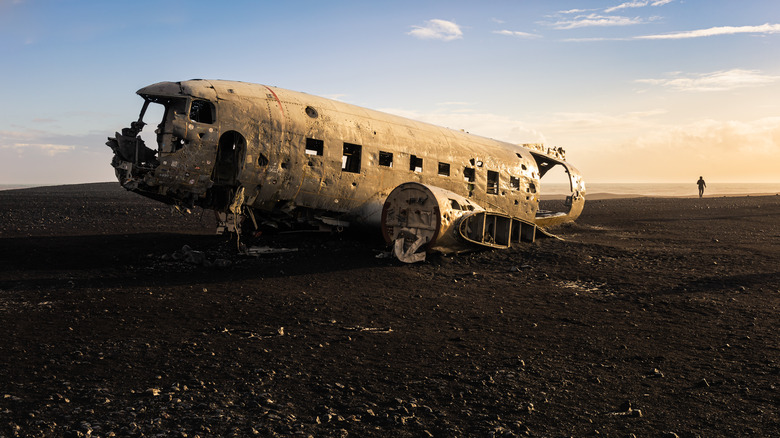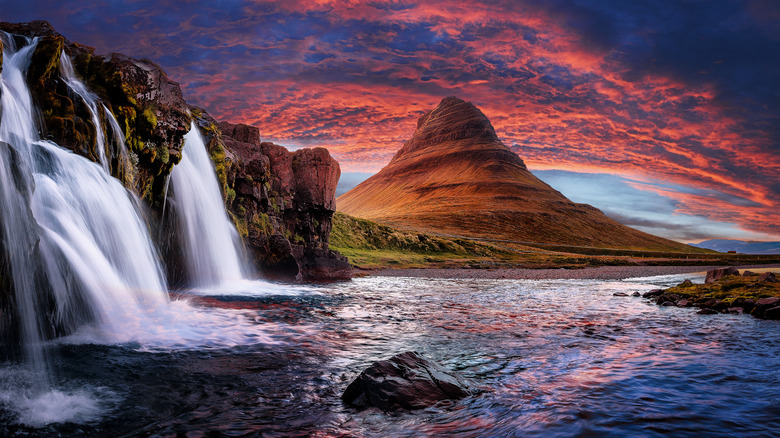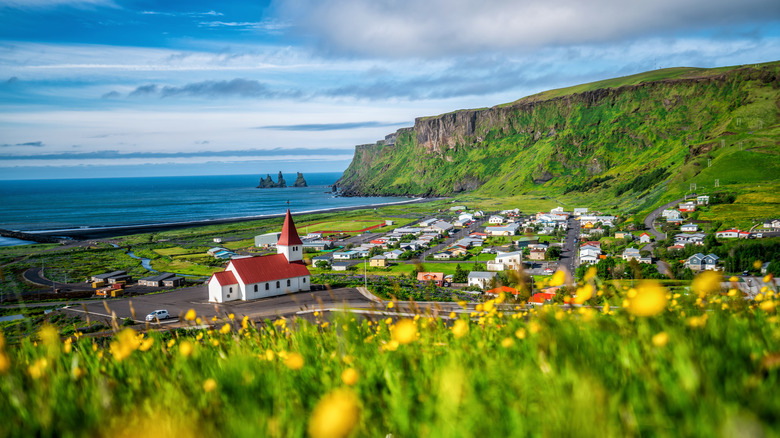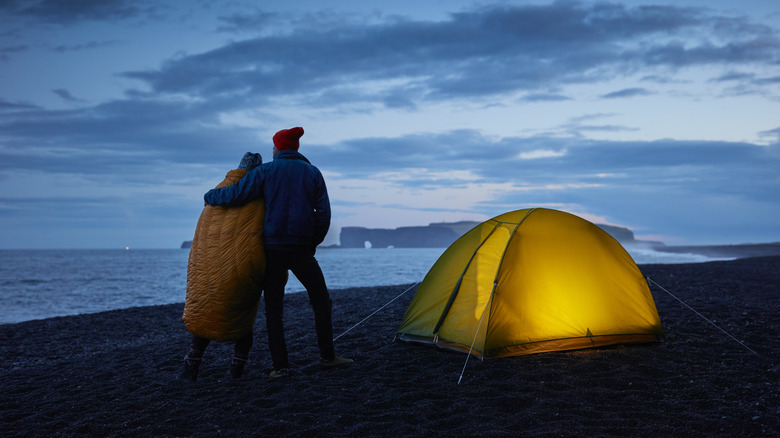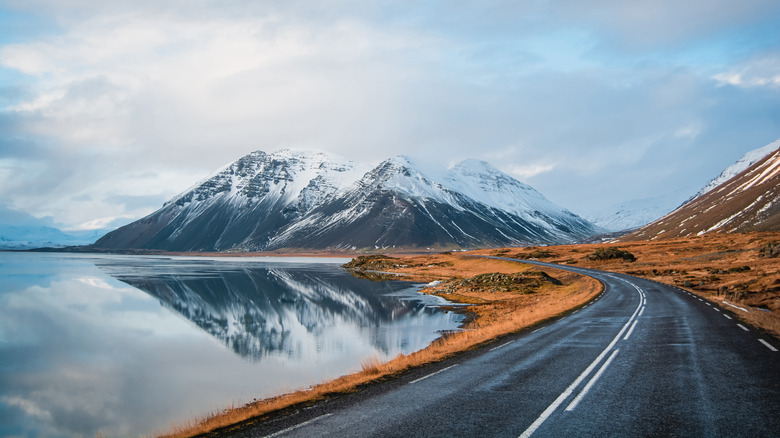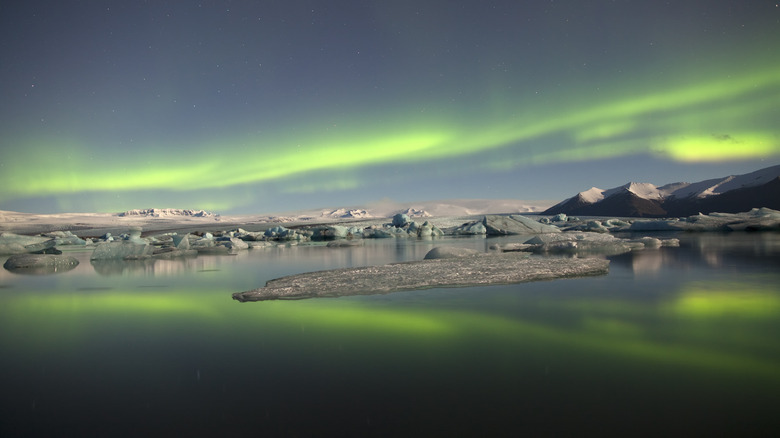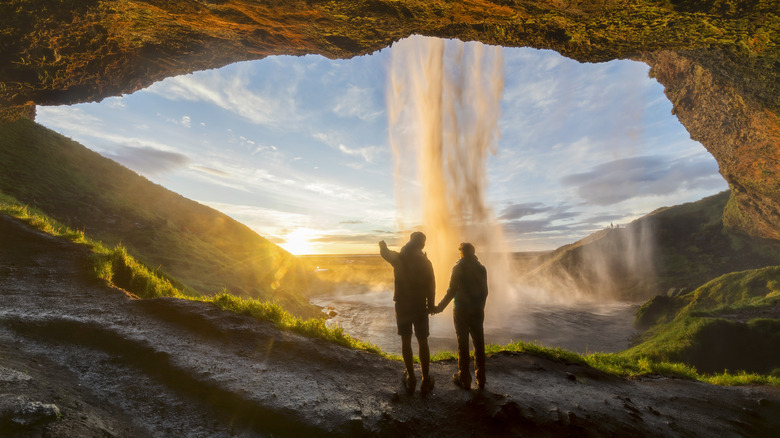Don't Overlook These Amazing Budget-Friendly Things To Do On Your Trip To Iceland
Iceland has become the sleeper hit of European travel. For decades, Iceland was an obscure volcanic island near the Arctic Circle, known only as an Icelandair pitstop for budget travelers. Yet by 2022, Iceland's tourism boom drew a full 1.7 million visitors, about 4.5 times the nation's population. The reasons are obvious: mythic scenery, immaculate infrastructure, and many direct flights from the United States have turned the land of ice into northern Europe's coolest vacation spot.
What's the catch? Iceland is pricey. Accommodations get competitive, especially in the summer, and nearly all household products must be imported. The price for dinners and drinks can add up, as can the obligatory rental car and tour fees. If you want to see puffins up close or experience the 4K planetarium at the Perlan Museum, expect to pay a pretty penny.
Yet Icelanders are also an intensely civic people, cultivating municipal spaces, public art, and national parks for all to enjoy. The island's most impressive feature is its otherworldly landscape, which is wide open and easy to explore. Very little in Iceland is "free," especially if you have to drive to a remote location to reach it. But you'll find lots of budget-friendly activities, in the capital city of Reykjavik and across the country, that are effectively unique to Iceland. If you blew your budget on planes and lodging, don't worry. Using personal experience as a guide, we'll share some experiences you can still enjoy, all for a reasonable price.
Hallgrímskirkja Church
The steeple of Hallgrimskirkja rises like a sharp stalagmite out of the Reykjavik skyline, and its striated gray facade has wowed visitors for years. This imposing Lutheran church stands at the top of the hill in the very center of Iceland's capital, and the tower is visible from miles away. The full structure took about four decades to build and was consecrated in 1986, making it far younger than other famous churches of Europe. Tourists can enter the building for free, attend a service, or just walk around the minimalist choir when it's open. There's also a plaza out front featuring a brawny statue of Leif Eriksson.
But the best part of visiting Hallgrímskirkja is its tower, which rises 244 feet above the street. The elevator to the top costs the equivalent of about $7, but the ascent is fast and the 360-degree views through the medieval-looking windows are incomparable. There is no better view of Reykjavik, and you can see the simple analog clock from the inside.
Explore Reykjavik's Shore Walk
Reykjavik is a busy seaport, and so much of its history revolves around the ocean. The city has invested heavily in its urban shore, building walkways, docks for cruise ships, and Harpa, a massive glass-and-steel concert hall. This district is replete with high-end shopping and diverse restaurants, and visitors could while away for entire days shopping and eating their way through the city. Truly, the high-season tourism deluge is no joke, so you may want to consider the best times of year to visit Iceland to avoid big crowds.
But you don't have to spend a lot of money to enjoy the Shore Walk. The Sun Voyager sculpture, which is designed to look like a modernist Norse ship, is just one of many public art pieces that grace the city. Many people end up here, especially in the warmer months, to watch sunsets over the bay. Floods of tourists make this a bustling, cosmopolitan corridor in the high season. Plazas and playgrounds seem to pop up whenever young children need space to run around. You can even download the Hopp app and rent a scooter for a few hours; they're dirt cheap and can zip you all through downtown in a matter of minutes.
Bicycle around the capital
The cycling season may be short this far north, but the entire city of Reykjavik is well-connected with bike paths, and summer tourists can rent a ride from several different shops. This part of Iceland is remarkably level, so you can pedal from the downtown waterfront to the Grótta Island Lighthouse, at the very tip of the peninsula, in less than a half-hour. You can then continue along the coast, skirting the airport and venturing into one quiet suburb after another.
Indeed, many of the towns in the Reykjanes region have multi-use paths running between them, so you could theoretically spend a sunny day walking or cycling from one village center to another. Some of the more intrepid travelers to Iceland bring their own bicycles and either take a spin around the developed southwest or take more ambitious bike tours around the island. Icelandic drivers tend to be respectful of bicycles, and the twin-lane paths are often separate from pedestrian walkways, making two wheels a great way to explore.
Reykjavik Zoo and Family Park
The Húsdýragarðurinn Zoo is a must-see for families, especially with young children. The zoo isn't enormous, but its size is fitting, given that isolated Iceland is home to only a limited number of species. Here, you can acquaint yourself with the island's livestock and wildlife, from horses and goats to Arctic foxes and the famous reindeer. Located in a quiet suburb just east of downtown Reykjavik, the zoo is easy to get to by taxi or scooter. Admission costs a little more than $11 for adults, and children under five are admitted free. More than 200,000 people visit the zoo annually, including residents and travelers.
The zoo is adjacent to the Family Park, which is like a whimsical combination of playground and carnival. Kids can take a spin on the carousel, recreate a pirate battle on a tall-ship play structure, or (in warm weather) pump a pedal boat around the ponds.
Nauthólsvik Geothermal Beach
You've probably heard of hot springs, but have you heard of a geothermal beach? Nauthólsvik is peculiar not only for its warm waters and jacuzzi-like pools but also for being within Reykjavik's city limits. Indeed, the beach is just south of the city's domestic airport, and you will likely see small planes flying overhead. The highest daily admission is the equivalent of $6, and visitors can spend all day sunbathing in the sand or warming themselves in the conspicuously sultry waters. Although the heating is technically geothermal, warm water is artificially pumped into the cove, so the pleasant temperatures follow a predictable schedule. The beach has restrooms and places to change, and special hot tubs are available as well.
Note that many of the towns and neighborhoods in Iceland have their own indoor swim centers, which typically have heated pools and even waterslides. These are extremely affordable and can be enjoyed any time of year, even in the dark of winter.
Cross a bridge to another continent
From a geologic perspective, Iceland is just a baby, having formed only 20 million years ago. Lava oozed out of the ocean, cooling and hardening into stark mountains and coal-colored fields. What made this possible was a crack in the earth's surface, a rift between tectonic plates. As a result, the western sliver of Iceland is considered part of North America, and the rest lies in Europe.
To help visualize this, the Icelandic government built a 50-foot-long pedestrian bridge over a shallow canyon. If you start on the western side, you're standing in "the Americas." Walk across the bridge, and you're now in "Eurasia." This high-concept bridge is located a little over an hour southwest of Reykjavik, and it's a popular spot for selfies. You can stroll the bridge itself or the slopes and depression beneath it. The best part: the bridge is open 24 hours a day and totally free to visit.
Reykjadalur Hot Spring River
The moment you say "Iceland," someone almost always responds, "Oh, go to Blue Lagoon!" This hot-spring development has become a world-famous wellness center, and if you have money to burn, Blue Lagoon is a rewarding place to relax. Influencers routinely photograph themselves among its steaming waters or inside the space-age spa, and you're pretty much guaranteed a good time.
But Iceland has lots of hot springs, and many of them are cheap to visit and more natural in character. The Reykjadalur Valley is located about an hour away from Reykjavik, and this misty river flows directly out of the mountains. The soothing waters gurgle over a rocky stream bed, and visitors can soak, splash, or sun-bathe in any arrangement they like. The creek is framed with boardwalks and simple changing stations, so that visitors can slip into swimsuits and stow their belongings on dry walkways. You'll have to drive to get there, and there is a park admission fee, which is best paid online. You'll also have to hike into the hills to reach the springs, but if you're in decent shape, getting there is half the fun.
Krýsuvikurbjarg Sea Cliffs
There is no shortage of scenic cliffs in Iceland, but Krýsuvikurbjarg is special for several reasons. It's located only an hour's drive from Reykjavik, plus a little extra time to trundle over the rocky access road. The grassy soil abruptly ends, dropping straight down into the ocean. Except for its dark volcanic slopes, the vertical walls of Krýsuvikurbjarg look much like the Cliffs of Dover. Foot paths snake their way across the land, granting visitors picturesque views of the windswept coast. The area is free to visit and hike around, and it's a little off the beaten path, so you won't encounter many crowds.
Krýsuvikurbjarg is popular among birders, who will find thousands of specimens nested among the crags, including puffins in the summertime. While you're there, you may also enjoy visiting the adorable local lighthouse, which is perched high up and painted orange.
See an abandoned DC plane
Luckily, there were no fatalities when this U.S. military plane expended its fuel and crashed into the dark sands of Sólheimasandur in 1973, so you probably won't disturb any restless spirits as you poke around its rusty ruins. The "abandoned DC plane" has lost its wings, windows, and most of its interior, but the fuselage remains largely intact, attracting many adventurous travelers to this obscure spot on the southern Icelandic coast. People have come here for decades to gaze at the ruins, but it's particularly popular among photographers and drone operators, who try to capture this haunting husk against the barren backdrop.
Sólheimasandur is a two-and-a-half-hour drive from Reykjavik, and you'll have to pay for parking in the designated lot. But the land is free to visit, and travelers are free to explore the plane as much as they like. More than one tourist has climbed on the plane's roof; just be careful around the jagged old metal.
Kirkjufell Mountain
There is no shortage of epic mountains in Iceland, and it's hard to believe than any particular peak would stand out. Yet the swirling cone of Kirkjufell is a favorite among locals and travelers alike. Translated as "Church Mountain," Kirkjufell stands alone, separate from any range. The slopes are sweeping and smooth, and the summit rises 1,519 feet above sea level. Steep as it is, Kirkjufell has a well-trod trail up its side, and most hikers can reach the top in about 90 minutes. The trailhead is about a two-and-a-half-hour drive from Reykjavik, making this hike a reasonable day-trip or an even better overnight excursion; you can stay in the beautiful village of Grundarfjör∂ur nearby.
Kirkjufell rises out of the Snæfellsnes peninsula, in the middle of the western coast. This region may feel isolated, but there are several villages along the route. While you're there, make sure to visit the Kirkjufell waterfalls (pictured above).
Explore small towns
The vast majority of Icelanders live in and around Reykjavík, but towns and villages are spread out along the full periphery of the island. Many of these places are sleepy fishing towns, which have been the backbone of Iceland's economy since time immemorial. Others are colorful, storybook villages that cater to tourists and host regular festivals and events. Populations range from a few hundred to a few thousand, but all have a walkable Main Street with (at least) basic amenities.
In recent years, modest seaside villages like Vik and Ísafjörður have transformed into getaways for kayaking and horseback riding, and even the remote fjord of Seyðisfjörður on the far-eastern coast offers its share of epic vistas and outdoor activities. Local houses are often rented out during the winter months, so real bargain-hunters may find a way to affordable stay in rural Iceland for extended periods. Nearly every town is connected by the national bus line, so you don't even have to rent a car.
Camping
Not long ago, Iceland had a reputation for being a trekkers' paradise, where tourists could set up a tent wherever they pleased. The government has since cracked down on wild camping, and it's only legal to overnight on an official campground. This is partly for the safety of outdoorspeople, but also to protect the rights of landowners, whose estates might not be well marked. Fortunately, there are more than 200 official campgrounds across the country, and you can almost always stay the night for less than $20.
Camping in Iceland is an economical option, as long as you don't mind taking loads of equipment on the plane. Because of the temperamental climate and rugged conditions, you should stock up on quality gear. Alternatively, several outfitters in Reykjavik rent camping equipment to travelers. You can also consult shop owners for recommended hiking routes and places to crash. If you're on a solo journey, you may need a refresher on how to master camping on your own.
Drive the Ring Road
The Ring Road is quickly becoming one of the most famous highways in the world, as it circumscribes the island with smooth, dependable pavement and extends 821 miles from Reykjavik and back again. The act of driving this road and admiring the endless succession of peaks and glaciers along the way has been added to many a bucket list in recent years. There isn't a single toll booth along this route, except for the Hvalfjarðargönginn tunnel, which you can navigate around. Except for car rental, gas, and lodging along the way, taking this journey is extremely kind to your wallet. Also, the best stops on Iceland's Ring Road may easily be your trip's highlights.
So, what if you don't feel like renting a car? You can take advantage of the Strætó bus system, whose 18 rural routes cover the entire Ring Road (and more). You can leave the driving to someone else and pay a fraction of the price, as long as you have a little patience and reserve places to stay along the way. For really adventurous travelers, Iceland's interior attracts more and more bikepackers every year, who pedal their way down the remotest roads and camp as they go.
See the northern lights
The aurora borealis is one of the most majestic natural occurrences on Earth, and looking up at the sky is free. Many travelers come to the country with the express purpose of seeing (and photographing) Iceland's northern lights — and truly, this is one of the most famous locations on Earth to observe them. That said, the emerald wisps are hard to predict, and the best time to view this cosmic phenomenon is between September and April, the chilliest months of the year. Keep in mind that the weather can shift unexpectedly in Iceland, and even perfect conditions can be ruined by sudden overcast or rain.
To increase your chances of seeing the northern lights, try to get away from big towns and other manmade sources of light pollution. Finding a remote location is best, where the sky is clear and unaffected by street lamps. Keep tabs on the media, as meteorologists can usually predict when the aurora borealis will be most visible. If you find yourself with a little money to spare, many Icelandic tour operators cater to aurora-chasers.
Celebrate the midnight sun
Fact: Iceland goes for a full month, from mid-June to mid-July, without experiencing "night." This period of 24-hour sunlight is the most invigorating on the Icelandic calendar, and it naturally triggers the tourism high season. That said, the "midnight sun" doesn't match what many people imagine: The sun doesn't linger straight above and shine at a high noon position for 30 days. More dramatically, the sun makes a strange journey toward the horizon, casting long shadows and a gloaming light, before turning around and easing back across the sky. You wouldn't know how strange this is unless you looked at your watch, realizing that sunrise and sunset are basically the same, even at 2 a.m.
Icelanders celebrate this season with "midsummer" festivals and concerts. The most famous event is the old folk tradition of Jónsmessa, which both celebrates John the Baptist and involves rolling (naked) down grassy hills. You don't have to partake in this free-spirited ritual, nor must you believe in the elves and talking cows that allegedly come out of the woodwork around this time. But if you do decide to tumble down a heath in your birthday suit, remember: It's free!
